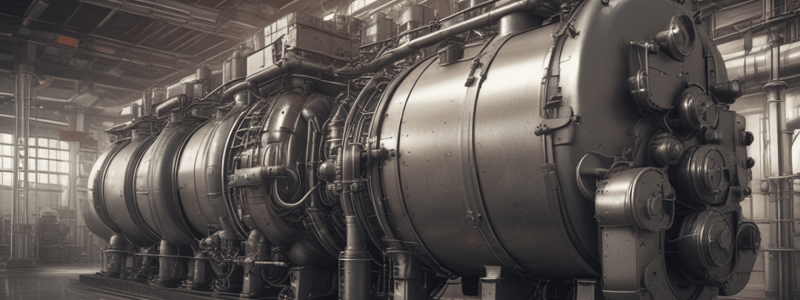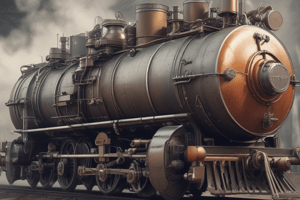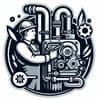Podcast
Questions and Answers
What is the main purpose of a steam condenser in a steam engine or turbine?
What is the main purpose of a steam condenser in a steam engine or turbine?
- To maintain a very low back pressure on the exhaust side (correct)
- To increase back pressure on the exhaust side
- To decrease the available heat energy for converting into mechanical work
- To decrease the thermal efficiency of the unit
What happens to the thermal efficiency of a condensing unit compared to a non-condensing unit?
What happens to the thermal efficiency of a condensing unit compared to a non-condensing unit?
- Thermal efficiency decreases
- Thermal efficiency increases (correct)
- Thermal efficiency remains constant
- No change in thermal efficiency
Which organ is responsible for removing the condensed steam, air, and uncondensed water vapor and gases from the condenser in a steam condensing plant?
Which organ is responsible for removing the condensed steam, air, and uncondensed water vapor and gases from the condenser in a steam condensing plant?
- Condenser
- Hot well
- Wet air pump (correct)
- Supply of cooling water
What is the function of the hot well in a steam condensing plant?
What is the function of the hot well in a steam condensing plant?
How does a steam condenser impact the available heat energy for converting into mechanical work?
How does a steam condenser impact the available heat energy for converting into mechanical work?
Which element of a steam condensing plant helps convert the condensed steam into boiler feed water?
Which element of a steam condensing plant helps convert the condensed steam into boiler feed water?
What is the primary function of a turbine nozzle?
What is the primary function of a turbine nozzle?
In what type of turbine does the nozzle direct high-velocity steam against blades?
In what type of turbine does the nozzle direct high-velocity steam against blades?
What is the purpose of the throat in a convergent-divergent nozzle?
What is the purpose of the throat in a convergent-divergent nozzle?
Why does a convergent-divergent nozzle produce steam at higher velocities compared to a convergent nozzle?
Why does a convergent-divergent nozzle produce steam at higher velocities compared to a convergent nozzle?
What leads to the reduction in final velocity of steam in a nozzle?
What leads to the reduction in final velocity of steam in a nozzle?
Why does friction between the nozzle surface and steam affect nozzle efficiency?
Why does friction between the nozzle surface and steam affect nozzle efficiency?
What is the main difference between a jet condenser and a surface condenser?
What is the main difference between a jet condenser and a surface condenser?
Which type of condenser is preferred when the cooling water can be easily made suitable for the boiler feed?
Which type of condenser is preferred when the cooling water can be easily made suitable for the boiler feed?
What is the purpose of the baffle plate in a low-level parallel-flow jet condenser?
What is the purpose of the baffle plate in a low-level parallel-flow jet condenser?
Which type of jet condenser obviates the need for an extraction pump due to its height above the hot well?
Which type of jet condenser obviates the need for an extraction pump due to its height above the hot well?
How does an ejector condenser function to draw in exhaust steam and associated air?
How does an ejector condenser function to draw in exhaust steam and associated air?
What distinguishes counter-flow type jet condensers from parallel-flow type?
What distinguishes counter-flow type jet condensers from parallel-flow type?
Why is a surface condenser commonly used?
Why is a surface condenser commonly used?
What happens to the kinetic energy in an ejector condenser's diverging cone?
What happens to the kinetic energy in an ejector condenser's diverging cone?
In what direction does cooling water flow in a single-pass surface condenser?
In what direction does cooling water flow in a single-pass surface condenser?
Which type of surface condenser has a provision for its own injection pump?
Which type of surface condenser has a provision for its own injection pump?
What is the formula to calculate corrected vacuum in mm of Hg?
What is the formula to calculate corrected vacuum in mm of Hg?
How is vacuum efficiency defined?
How is vacuum efficiency defined?
What does condenser efficiency measure?
What does condenser efficiency measure?
How are cooling towers classified based on the material used?
How are cooling towers classified based on the material used?
What is a disadvantage of natural draught cooling towers?
What is a disadvantage of natural draught cooling towers?
In a cooling tower, what is cooled due to evaporation?
In a cooling tower, what is cooled due to evaporation?
What is the main function of a steam nozzle?
What is the main function of a steam nozzle?
What is the formula for calculating vacuum efficiency?
What is the formula for calculating vacuum efficiency?
'Condenser efficiency' can be defined as _____.
'Condenser efficiency' can be defined as _____.
'Cooling Towers' are used in power plants primarily for _____.
'Cooling Towers' are used in power plants primarily for _____.
What type of condenser has the air suction at the top, with steam rising up and then flowing back down near the outer surface of the condenser?
What type of condenser has the air suction at the top, with steam rising up and then flowing back down near the outer surface of the condenser?
Which type of condenser is applied to condensers adopting a regenerative method of heating of the condensate?
Which type of condenser is applied to condensers adopting a regenerative method of heating of the condensate?
What is the main advantage of a surface condenser mentioned in the text?
What is the main advantage of a surface condenser mentioned in the text?
What is a key disadvantage of surface condensers according to the text?
What is a key disadvantage of surface condensers according to the text?
Which type of condenser requires proper cleaning of cooling water to avoid accumulation of dust inside the tubes?
Which type of condenser requires proper cleaning of cooling water to avoid accumulation of dust inside the tubes?
In which type of condenser is there no direct contact between cooling water and steam, allowing even poor quality cooling water to be used?
In which type of condenser is there no direct contact between cooling water and steam, allowing even poor quality cooling water to be used?
What does a vacuum in case of a condenser mean?
What does a vacuum in case of a condenser mean?
Flashcards are hidden until you start studying
Study Notes
Classification of Condensers
- Jet Condensers:
- Exhaust steam and water come in direct contact
- Temperature of condensate is the same as cooling water leaving the condenser
- Types: parallel-flow, counter-flow, and ejector types
- Surface Condensers:
- Exhaust steam and water do not come in direct contact
- Steam passes over outer surface of tubes through which cooling water is maintained
- Types: single-pass, double-pass, down flow, central flow, inverted flow, regenerative, and evaporative types
Low Level Jet Condensers
- Parallel-flow type:
- Exhaust steam and cooling water enter from the top and flow downwards
- Baffle plate ensures proper mixing of steam and cooling water
- Extraction pump discharges condensate to the hot well
- Counter-flow type:
- Steam moves upwards and comes in contact with water, which gets condensed
- Condensate and water mixture is sent to the hot well by an extraction pump
- Air is removed by an air suction pump
High Level Jet Condensers
- Counter-flow type:
- Shell is placed at a height of about 10 meters above the hot well
- No extraction pump is required, but an injection pump is needed if water is not under pressure
Ejector Condensers
- Exhaust steam and cooling water mix in hollow truncated cones
- Cold water flows down through the cones, increasing its velocity and decreasing its pressure
- Exhaust steam and air are drawn through the cones and finally lead to a diverging cone
- Condensate is discharged into the hot well
Nozzles
- Types: convergent, convergent-divergent
- Convergent-divergent nozzles produce steam at higher velocities due to higher expansion ratio
- Nozzle efficiency is affected by frictional losses, including friction between nozzle surface and steam, internal friction of steam, and shock losses
Steam Condensing Plant
- Organs: condenser, supply of cooling water, wet air pump, hot well, and vacuum gauge
- Functions: maintains low back pressure, supplies pure and hot feed water to the boiler, and increases thermal efficiency
Vacuum Efficiency
- Defined as the ratio of actual vacuum to maximum obtainable vacuum
- Maximum obtainable vacuum is obtained when there is only steam and no air in the condenser
Condenser Efficiency
- Defined as the ratio of the difference between outlet and inlet temperatures of cooling water to the difference between temperature corresponding to the vacuum in the condenser and inlet temperature of cooling water
Cooling Towers
- Types: natural draught, mechanical draught (forced draught and induced draught)
- Factors affecting cooling: temperature of air, humidity, temperature of hot water, size and height of tower, velocity of air, accessibility of air, degree of uniformity in descending water, and arrangement of plates
Surface Condensers
- Advantages: slightly better vacuum, no need to treat condensate chemically, high vacuum, condensate can be reused, low pumping power, and less chances of losing vacuum
- Disadvantages: high initial cost, large floor area, high maintenance cost, more head is necessary, and proper cleaning of cooling water is necessary
Studying That Suits You
Use AI to generate personalized quizzes and flashcards to suit your learning preferences.






